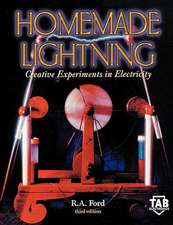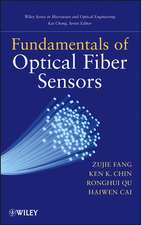Optically Active Charge Traps and Chemical Defects in Semiconducting Nanocrystals Probed by Pulsed Optically Detected Magnetic Resonance: Springer Theses
Autor Kipp van Schootenen Limba Engleză Hardback – 30 iul 2013
This thesis outlines pulsed optically detected magnetic resonance as a powerful spectroscopy of the chemical and electronic nature of these deleterious states. Counterintuitive for such heavy atom materials, some trap species possess very long spin coherence lifetimes (up to 1.6 µs). This quality allows use of the trapped charge's magnetic moment as a local probe of the trap state itself and its local environment. Beyond state characterization, this spectroscopy can demonstrate novel effects in heterostructured nanocrystals, such as spatially-remote readout of spin information and the coherent control of light harvesting yield.
| Toate formatele și edițiile | Preț | Express |
|---|---|---|
| Paperback (1) | 631.07 lei 6-8 săpt. | |
| Springer International Publishing – 9 aug 2015 | 631.07 lei 6-8 săpt. | |
| Hardback (1) | 638.43 lei 6-8 săpt. | |
| Springer International Publishing – 30 iul 2013 | 638.43 lei 6-8 săpt. |
Din seria Springer Theses
- 18%
 Preț: 997.88 lei
Preț: 997.88 lei -
 Preț: 389.88 lei
Preț: 389.88 lei - 15%
 Preț: 646.94 lei
Preț: 646.94 lei - 18%
 Preț: 943.43 lei
Preț: 943.43 lei -
 Preț: 399.29 lei
Preț: 399.29 lei - 18%
 Preț: 944.99 lei
Preț: 944.99 lei - 15%
 Preț: 636.80 lei
Preț: 636.80 lei - 18%
 Preț: 941.05 lei
Preț: 941.05 lei - 15%
 Preț: 643.16 lei
Preț: 643.16 lei - 15%
 Preț: 642.68 lei
Preț: 642.68 lei - 18%
 Preț: 1103.62 lei
Preț: 1103.62 lei - 20%
 Preț: 558.82 lei
Preț: 558.82 lei - 18%
 Preț: 1112.30 lei
Preț: 1112.30 lei - 18%
 Preț: 944.19 lei
Preț: 944.19 lei - 18%
 Preț: 1109.92 lei
Preț: 1109.92 lei - 18%
 Preț: 1217.27 lei
Preț: 1217.27 lei - 15%
 Preț: 640.06 lei
Preț: 640.06 lei - 15%
 Preț: 636.45 lei
Preț: 636.45 lei - 15%
 Preț: 640.06 lei
Preț: 640.06 lei - 15%
 Preț: 640.88 lei
Preț: 640.88 lei -
 Preț: 389.70 lei
Preț: 389.70 lei - 20%
 Preț: 563.89 lei
Preț: 563.89 lei -
 Preț: 393.35 lei
Preț: 393.35 lei - 15%
 Preț: 637.93 lei
Preț: 637.93 lei - 15%
 Preț: 641.85 lei
Preț: 641.85 lei - 18%
 Preț: 1225.94 lei
Preț: 1225.94 lei - 20%
 Preț: 551.36 lei
Preț: 551.36 lei - 18%
 Preț: 1229.10 lei
Preț: 1229.10 lei - 15%
 Preț: 639.25 lei
Preț: 639.25 lei - 18%
 Preț: 999.45 lei
Preț: 999.45 lei - 15%
 Preț: 640.06 lei
Preț: 640.06 lei - 18%
 Preț: 1220.45 lei
Preț: 1220.45 lei - 18%
 Preț: 1116.26 lei
Preț: 1116.26 lei - 18%
 Preț: 1110.72 lei
Preț: 1110.72 lei - 18%
 Preț: 1000.87 lei
Preț: 1000.87 lei - 18%
 Preț: 891.17 lei
Preț: 891.17 lei - 15%
 Preț: 640.06 lei
Preț: 640.06 lei - 5%
 Preț: 1154.07 lei
Preț: 1154.07 lei - 15%
 Preț: 635.96 lei
Preț: 635.96 lei - 15%
 Preț: 640.88 lei
Preț: 640.88 lei -
 Preț: 387.20 lei
Preț: 387.20 lei - 18%
 Preț: 1109.92 lei
Preț: 1109.92 lei -
 Preț: 385.25 lei
Preț: 385.25 lei -
 Preț: 385.25 lei
Preț: 385.25 lei - 18%
 Preț: 1112.30 lei
Preț: 1112.30 lei - 18%
 Preț: 999.45 lei
Preț: 999.45 lei -
 Preț: 386.99 lei
Preț: 386.99 lei - 15%
 Preț: 637.13 lei
Preț: 637.13 lei - 20%
 Preț: 554.20 lei
Preț: 554.20 lei - 20%
 Preț: 555.57 lei
Preț: 555.57 lei
Preț: 638.43 lei
Preț vechi: 751.10 lei
-15% Nou
Puncte Express: 958
Preț estimativ în valută:
122.16€ • 127.55$ • 101.11£
122.16€ • 127.55$ • 101.11£
Carte tipărită la comandă
Livrare economică 04-18 aprilie
Preluare comenzi: 021 569.72.76
Specificații
ISBN-13: 9783319005898
ISBN-10: 3319005898
Pagini: 104
Ilustrații: XIV, 90 p. 28 illus. in color.
Dimensiuni: 155 x 235 x 11 mm
Greutate: 0.36 kg
Ediția:2013
Editura: Springer International Publishing
Colecția Springer
Seria Springer Theses
Locul publicării:Cham, Switzerland
ISBN-10: 3319005898
Pagini: 104
Ilustrații: XIV, 90 p. 28 illus. in color.
Dimensiuni: 155 x 235 x 11 mm
Greutate: 0.36 kg
Ediția:2013
Editura: Springer International Publishing
Colecția Springer
Seria Springer Theses
Locul publicării:Cham, Switzerland
Public țintă
ResearchCuprins
Introduction.- Experimental Methods.- Spin-Dependent Exciton Quenching and Intrinsic Spin Coherence in CDSE/CDS Nanocrystals.- Towards Chemical Fingerprinting of Deep-Level Defect Sites in CDS Nanocrystals by Optically Detected Spin Coherence.- Summary of Work.
Notă biografică
Kipp van Schooten
Department of Physics and Astronomy
University of Utah
Salt Lake City, UT, 84112
USA
Kipp van Schooten received his Ph.D. in Physics (Condensed Matter focus) from the University of Utah in December 2012. He received the Outstanding Teaching Assistant award each year from 2005 - 2009 for the courses "Intro to Quantum Relativity" and "Solid State Physics II." In 2011, he also received first place for Best Graduate Student Oral Presentation at the University of Utah.
Department of Physics and Astronomy
University of Utah
Salt Lake City, UT, 84112
USA
Kipp van Schooten received his Ph.D. in Physics (Condensed Matter focus) from the University of Utah in December 2012. He received the Outstanding Teaching Assistant award each year from 2005 - 2009 for the courses "Intro to Quantum Relativity" and "Solid State Physics II." In 2011, he also received first place for Best Graduate Student Oral Presentation at the University of Utah.
Textul de pe ultima copertă
Colloidal nanocrystals show much promise as an optoelectronics architecture due to facile control over electronic properties afforded by chemical control of size, shape, and heterostructure. Unfortunately, realizing practical devices has been forestalled by the ubiquitous presence of charge "trap" states which compete with band-edge excitons and result in limited device efficiencies. Little is known about the defining characteristics of these traps, making engineered strategies for their removal difficult.
This thesis outlines pulsed optically detected magnetic resonance as a powerful spectroscopy of the chemical and electronic nature of these deleterious states. Counterintuitive for such heavy atom materials, some trap species possess very long spin coherence lifetimes (up to 1.6 µs). This quality allows use of the trapped charge's magnetic moment as a local probe of the trap state itself and its local environment. Beyond state characterization, this spectroscopy can demonstrate novel effects in heterostructured nanocrystals, such as spatially-remote readout of spin information and the coherent control of light harvesting yield.
This thesis outlines pulsed optically detected magnetic resonance as a powerful spectroscopy of the chemical and electronic nature of these deleterious states. Counterintuitive for such heavy atom materials, some trap species possess very long spin coherence lifetimes (up to 1.6 µs). This quality allows use of the trapped charge's magnetic moment as a local probe of the trap state itself and its local environment. Beyond state characterization, this spectroscopy can demonstrate novel effects in heterostructured nanocrystals, such as spatially-remote readout of spin information and the coherent control of light harvesting yield.
Caracteristici
Nominated by the University of Utah, USA, as an outstanding Ph.D. thesis Lays the groundwork for further use of Electron Spin Echo Envelop Modulation (ESEEM) and opens the possibility of highly precise chemical fingerprinting Reveals an astonishingly long memory of spin coherence in semiconductor particles







